Integrating SAP and Salesforce can significantly enhance business operations. According to a study by McKinsey & Company, companies utilizing integrated cloud-based CRM systems experienced a 30% increase in customer retention and a 25% rise in revenue.
By connecting SAP’s ERP capabilities with Salesforce’s CRM functionalities, businesses can streamline workflows, eliminate data silos, and make faster, more informed decisions.
This integration ensures that teams across finance, sales, and customer service have access to consistent, up-to-date information, improving forecasting accuracy and customer relationships.
In this article, we'll explore how integrating SAP with Salesforce can transform your business operations through process automation, enhancing efficiency, decision-making, and customer satisfaction.
Why Integrate SAP with Salesforce?
Salesforce SAP integration creates a powerful ecosystem that connects the back-end operations of an enterprise resource planning (ERP) system with the front-end customer relationship management (CRM) system. This integration streamlines business processes, improves decision-making, and enhances customer satisfaction. By combining SAP’s operational and financial data with Salesforce’s customer-facing tools, businesses can benefit from seamless workflows, better insights, and increased efficiency. Below, we explore the key benefits in more detail.
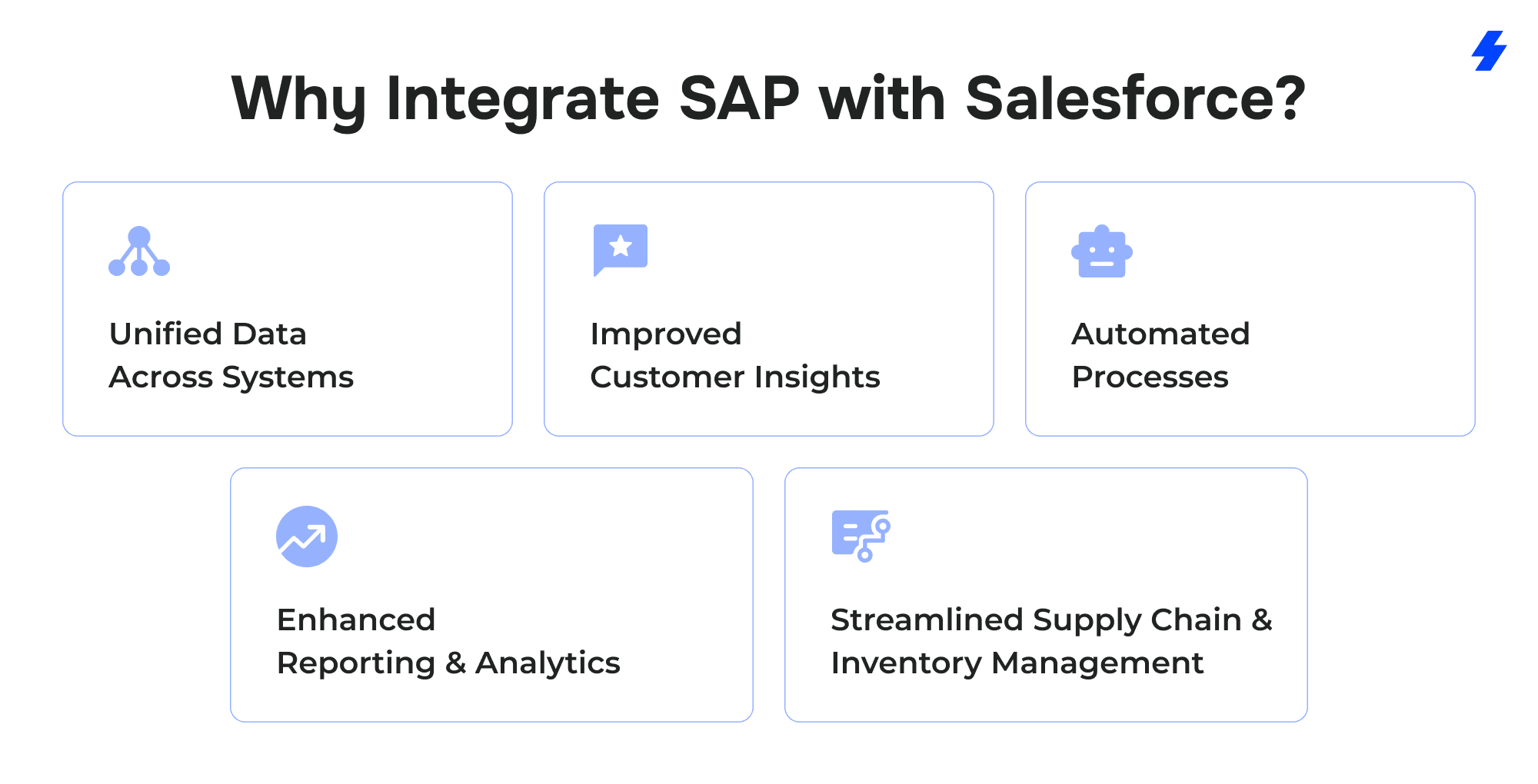
1. Unified Data Across Systems
A significant advantage of integrating a SAP system with Salesforce is the elimination of data silos between your enterprise’s core operations and customer-facing functions. SAP handles a wide range of processes such as financial management, supply chain logistics, inventory tracking, and procurement, while Salesforce excels at managing customer relationships, sales processes, and marketing campaigns.
By integrating these systems, data from both platforms is synchronized, ensuring that teams across departments, including sales, marketing, finance, and customer service, work with the same, up-to-date information. This unified data view helps businesses make informed decisions by ensuring consistency across the organization and improving data management.
For example, when a sales representative closes a deal in Salesforce, the corresponding order details and customer information can be automatically updated in SAP, improving accuracy and reducing the need for manual data entry.
2. Improved Customer Insights
When SAP and Salesforce are integrated, businesses gain a holistic view of their customers, which is invaluable for customer service teams combining transactional data from SAP and relationship management data from Salesforce. This comprehensive perspective allows organizations to better understand customer behaviors, preferences, and buying patterns, which can be leveraged to personalize services and enhance customer engagement.
For example, with integrated data, a customer service representative can view a customer’s purchase history, payment status, and order fulfillment details all within Salesforce. The integration eliminates the need to switch between SAP and Salesforce systems, leading to faster, more efficient customer support.
Moreover, this unified customer view helps sales teams gain insights into buying trends, enabling them to predict customer needs better and identify cross-selling or up-selling opportunities. When sales teams access this valuable data, enabling them to offer tailored recommendations, boosting sales and increasing overall revenue.
3. Automated Processes
Integrating SAP with Salesforce automates many of the manual tasks that typically slow down business operations. The integration allows for the smooth flow of information between SAP and Salesforce, automating processes such as order-to-cash workflows, invoicing, inventory management, and customer support ticketing.
For example, when a sales order is closed in Salesforce, the details are automatically transferred to SAP, where inventory levels are updated, and invoices are generated. This not only eliminates manual data entry but also reduces the risk of errors, such as incorrect billing or stock discrepancies, which are common when data must be entered manually into different systems.
4. Enhanced Reporting & Analytics
Integrating SAP with Salesforce allows businesses to generate more accurate and insightful reports by combining data from both systems. Salesforce excels in providing analytics and reports related to sales performance, customer engagement, and marketing effectiveness. On the other hand, SAP provides in-depth insights into financial data, supply chain performance, and operational metrics.
By merging these two sets of data, businesses gain a comprehensive view of their overall performance, enabling accurate forecasts, optimized supply chains, and deeper customer insights.
For example, finance teams can use combined data from Salesforce’s sales pipeline and SAP’s financial records to generate detailed revenue forecasts, while marketing teams can analyze how customer behavior correlates with sales performance, enabling them to refine their strategies.
5. Streamlined Supply Chain & Inventory Management
SAP’s supply chain and inventory management modules, when integrated with Salesforce, provide real-time visibility into stock levels, order statuses, and delivery schedules. This integration ensures that sales teams have accurate, up-to-date information about product availability, enabling them to provide better service to customers and manage customer expectations effectively.
When sales representatives access integrated data from SAP, they can view inventory levels in real time and avoid overpromising on stock availability. This prevents customer dissatisfaction due to stockouts, streamlines supply chain operations, and ensures timely order fulfillment.
Key Features of SAP and Salesforce Integration
Integrating SAP with Salesforce combines the strengths of both systems, enhancing financial management, order processing, and customer service. The integration enables seamless data flow across business functions, automating processes and providing valuable insights. Here are the key features businesses can leverage by integrating these two powerful platforms:
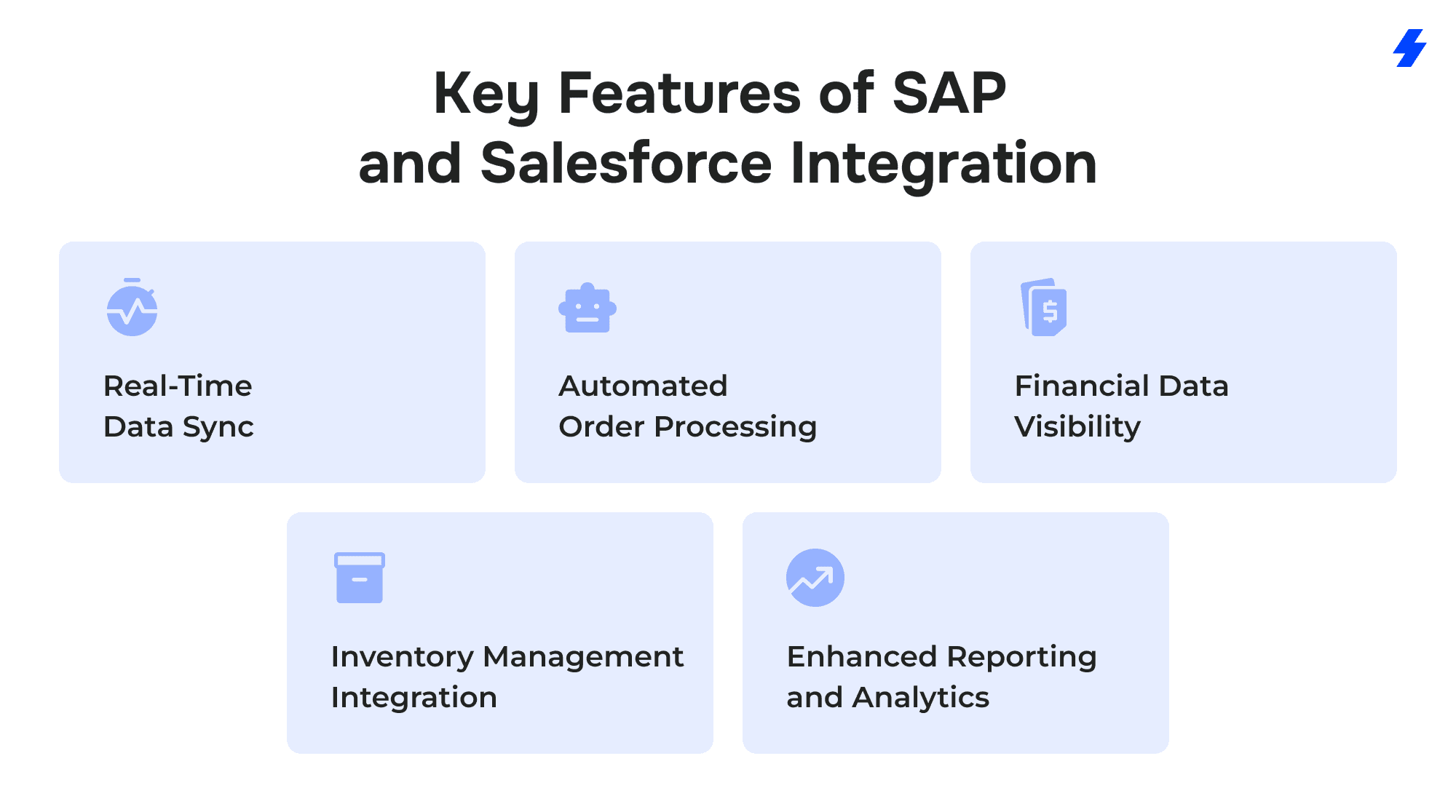
1. Real-Time Data Sync
One of the most significant benefits of integrating SAP with Salesforce is synchronizing data across both systems in real time. Businesses can eliminate manual data entry errors and avoid discrepancies by ensuring that updates to customer information, orders, inventory, and financial data are automatically reflected in both SAP and Salesforce.
This synchronization provides a unified view of data across departments, ensuring that sales, finance, and operations teams have access to the most current information. For example, when a sales team updates a customer's order status in Salesforce, the data is instantly reflected in SAP, improving accuracy and operational efficiency.
Benefit: This real-time data sync reduces the risk of outdated or inconsistent information, enabling more accurate decision-making and improving customer service.
2. Automated Order Processing
Integrating SAP’s order management system with Salesforce enables automation throughout the order-to-cash process. When an opportunity is closed in Salesforce, the order details can be automatically transferred to SAP, initiating processes like invoicing, inventory updates, and shipment tracking. This automated flow eliminates the need for manual entry and ensures that orders are processed more efficiently.
Automated order processing improves order accuracy and fulfillment speed by eliminating delays and manual errors. The integration allows for smoother collaboration between sales, finance, and logistics teams, leading to faster customer delivery and improved satisfaction.
Benefit: Automation in order processing reduces delays and manual errors, improving both order accuracy and fulfillment speed.
3. Financial Data Visibility
Integrating SAP’s financial data with Salesforce enables sales and finance teams to access up-to-date financial information directly within the Salesforce platform. By having financial data, such as payment status, invoicing, and revenue forecasting, available in Salesforce, businesses can improve their decision-making and provide a more accurate view of their financial health.
This integration makes it easier for sales teams to monitor overdue accounts, identify payment trends, and promptly address issues, helping optimize cash flow. Additionally, finance teams can leverage combined data from both systems to generate more accurate revenue forecasts and make better-informed budget decisions.
Benefit: With financial data readily available in Salesforce, businesses can improve cash flow management, reduce errors, and make more accurate revenue forecasts.
4. Inventory Management Integration
The integration between SAP’s inventory management system and Salesforce allows businesses to manage stock levels more effectively. By syncing inventory data across systems, sales teams can instantly check the availability of products, preventing over-ordering or under-ordering. This integration ensures that inventory data in SAP is accurately reflected in Salesforce, providing sales teams with real-time visibility of stock levels.
For example, when a customer places an order in Salesforce, the system can automatically check SAP for inventory availability. If stock is low, the system can trigger a restock alert or prevent the sale from being processed until inventory is replenished. This helps businesses avoid customer dissatisfaction due to stockouts while optimizing inventory turnover.
Benefit: With synchronized inventory data, businesses can streamline supply chain management, reduce stockouts, and optimize inventory levels.
5. Enhanced Reporting and Analytics
By combining data from SAP and Salesforce, businesses gain access to more comprehensive and actionable insights. The integration enables businesses to create detailed, cross-functional reports that combine sales data from Salesforce with operational and financial data from SAP. This comprehensive data view supports better forecasting, performance tracking, and strategy development.
For example, businesses can generate reports that analyze sales performance alongside inventory levels, supply chain efficiency, and financial metrics. These insights help businesses identify trends, forecast future demand, and make more informed decisions across departments.
Benefit: The integration enhances reporting and analytics capabilities, enabling more accurate performance tracking, better forecasting, and smarter decision-making.
Step-by-Step Guide to Integrating SAP with Salesforce
Integrating SAP with Salesforce brings together the power of enterprise resource planning (ERP) with customer relationship management (CRM), enabling businesses to streamline operations, improve efficiency, and enhance decision-making. Below is a clear, actionable guide to implementing SAP integration with Salesforce, ensuring your integration process runs smoothly.
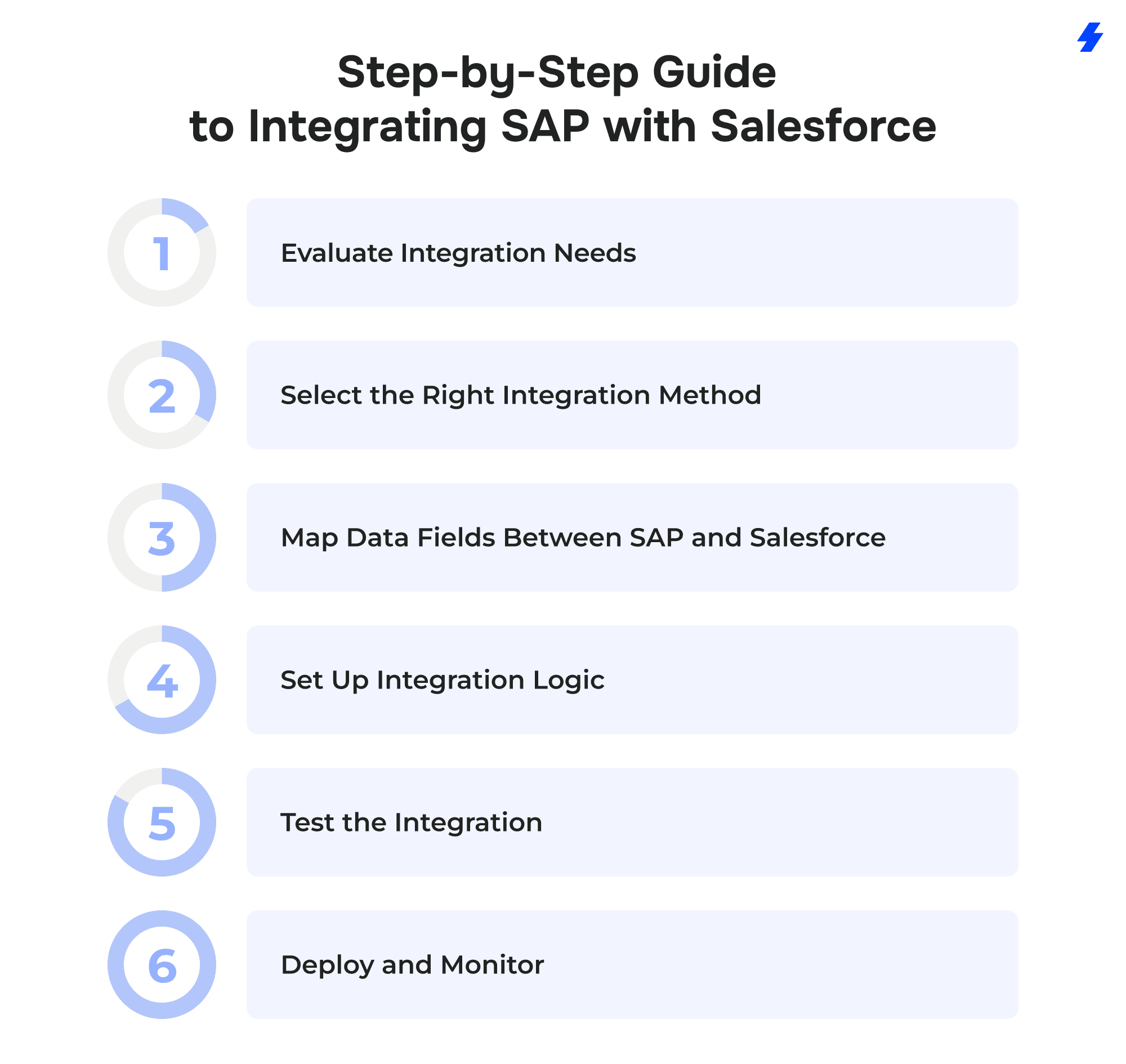
1. Evaluate Integration Needs
Before diving into the integration process, it’s crucial to evaluate your business processes and understand what areas will benefit the most from this integration.
-
Identify Key Business Processes: Determine which processes in your business will benefit from the integration, such as order management, customer service, finance, or inventory management. For instance, integrating Salesforce's customer service tools with SAP’s inventory management will streamline customer inquiries and order fulfillment.
-
Assess SAP and Salesforce Versions: Understand which versions of SAP (e.g., SAP S/4HANA, SAP ERP) and Salesforce editions (e.g., Salesforce Sales Cloud, Service Cloud, or Marketing Cloud) you are using. This will help ensure compatibility between the systems and determine the integration requirements.
Tip: Ensure your SAP and Salesforce versions are up to date to access the latest features and security enhancements.
2. Select the Right Integration Method
Choosing the right integration method is essential for ensuring a smooth data flow between SAP and Salesforce.
-
Middleware Integration: For businesses looking for an out-of-the-box solution, integration platforms like MuleSoft or SAP Cloud Platform Integration (CPI) can facilitate seamless data flow between SAP and Salesforce. These platforms often come with pre-built connectors and templates for easier setup and maintenance.
-
API Integration: For more customized integrations, you can use Salesforce APIs (REST or SOAP) and SAP’s OData or SOAP services. This method is ideal for businesses with unique requirements that need a tailored integration. API-based integration is flexible but may require more development resources and expertise.
Tip: Middleware solutions are often faster to deploy, while API integrations offer more flexibility and customization.
3. Map Data Fields Between SAP and Salesforce
Mapping data fields is one of the most critical steps in the integration process. It ensures that data from SAP is correctly transferred to Salesforce and vice versa.
-
Identify Data Types and Objects: Identify which SAP data needs to be transferred to Salesforce, such as SAP orders to Salesforce opportunities or SAP customers to Salesforce accounts. Ensure that the data types in both systems match, and if necessary, map fields like product names, order statuses, and customer details.
-
Ensure Data Consistency: Make sure that data from SAP is translated properly into Salesforce objects, avoiding data discrepancies and ensuring that both systems share the same terminology and data formats.
Tip: Use an integration mapping tool or platform to automate this process and reduce manual errors.
Consider Data Transformation Needs:
Data transformation may be necessary for certain fields due to differences in formatting between SAP and Salesforce. For example:
-
Date Formats: SAP and Salesforce may use different date formats (e.g., YYYY-MM-DD vs. MM/DD/YYYY).
-
Currency Conversions: Ensure currency data is properly mapped and converted to match the format in Salesforce, especially if dealing with international sales.
-
Code Lists: SAP and Salesforce might use different codes for the same entities (e.g., product codes or customer status codes). Make sure to create a mapping for these codes to avoid confusion and discrepancies.
4. Set Up Integration Logic
Setting up the integration logic helps automate processes and ensures data syncs seamlessly between the two systems.
-
Data Sync Rules: Configure automatic syncing rules, such as triggering an opportunity creation in Salesforce whenever an order is placed in SAP or updating customer information across both platforms in real time. For example, when an order is processed in SAP, Salesforce can automatically create a lead or opportunity for the sales team.
-
Define Trigger Points: Determine the specific events or actions in SAP that should trigger changes in Salesforce, and vice versa. Common triggers include order creation, payment processing, and customer profile updates.
Tip: Use tools like Salesforce Flow, Apex Triggers, or Platform Events for custom automation.
5. Test the Integration
Before going live, it’s crucial to test the integration to ensure everything works as expected thoroughly.
-
Run Test Transactions: Simulate various business scenarios to test data flow between SAP and Salesforce. Ensure that data is transferred correctly, triggers fire as expected, and the information is accurate in both systems.
-
Identify and Fix Issues: Troubleshoot the integration if you encounter discrepancies or errors. Ensure that all data is accurately mapped and workflows are functioning correctly.
Tip: Test across different departments, such as sales, finance, and inventory management, to ensure all teams can benefit from the integration.
Use Sandbox Environments for Safe Testing:
Both Salesforce and SAP provide sandbox environments where you can perform testing without affecting your live production data. These environments are ideal for testing integrations and resolving potential issues before deploying the solution to production.
By using sandbox environments, you can safely conduct end-to-end testing and ensure the integration is robust and reliable without any risk to your live business operations.
6. Deploy and Monitor
Once testing is complete and the integration functions as expected, it will be deployed to the production environment.
-
Deploy to Production: Roll out the integration in a phased manner to avoid disruption in your business operations. Ensure that all users are trained on how to use the integrated systems effectively.
-
Monitor the Integration: Continuous monitoring is crucial to ensure that the data sync between SAP and Salesforce remains smooth and error-free. Use Salesforce’s reporting tools and SAP monitoring solutions to track data flow, identify potential issues, and make adjustments as needed.
Tip: Set up alerts or notifications for potential issues, such as data sync errors or workflow failures, to quickly address problems as they arise.
Key Tools for Monitoring:
- SAP Application Interface Framework (AIF): AIF is used to monitor and manage SAP integrations, allowing you to track and troubleshoot issues within SAP.
- Salesforce Debug Logs: Use Salesforce Debug Logs to monitor and troubleshoot issues in Apex code or workflows.
- Salesforce Flow Errors: Flow Errors help identify any issues within automated workflows in Salesforce.
- Salesforce Integration User Audit Logs: These logs track user activity related to integrations, allowing for better insight into actions and potential errors in the system.
Best Practices for Optimizing SAP-Salesforce Integration
Successfully integrating SAP with Salesforce can drastically improve operational efficiency and decision-making. To ensure businesses get the most out of their SAP-Salesforce integration, it is essential to follow best practices that optimize performance, maintain data accuracy, and future-proof the integration. Below are key best practices for achieving a seamless and efficient integration between SAP and Salesforce.
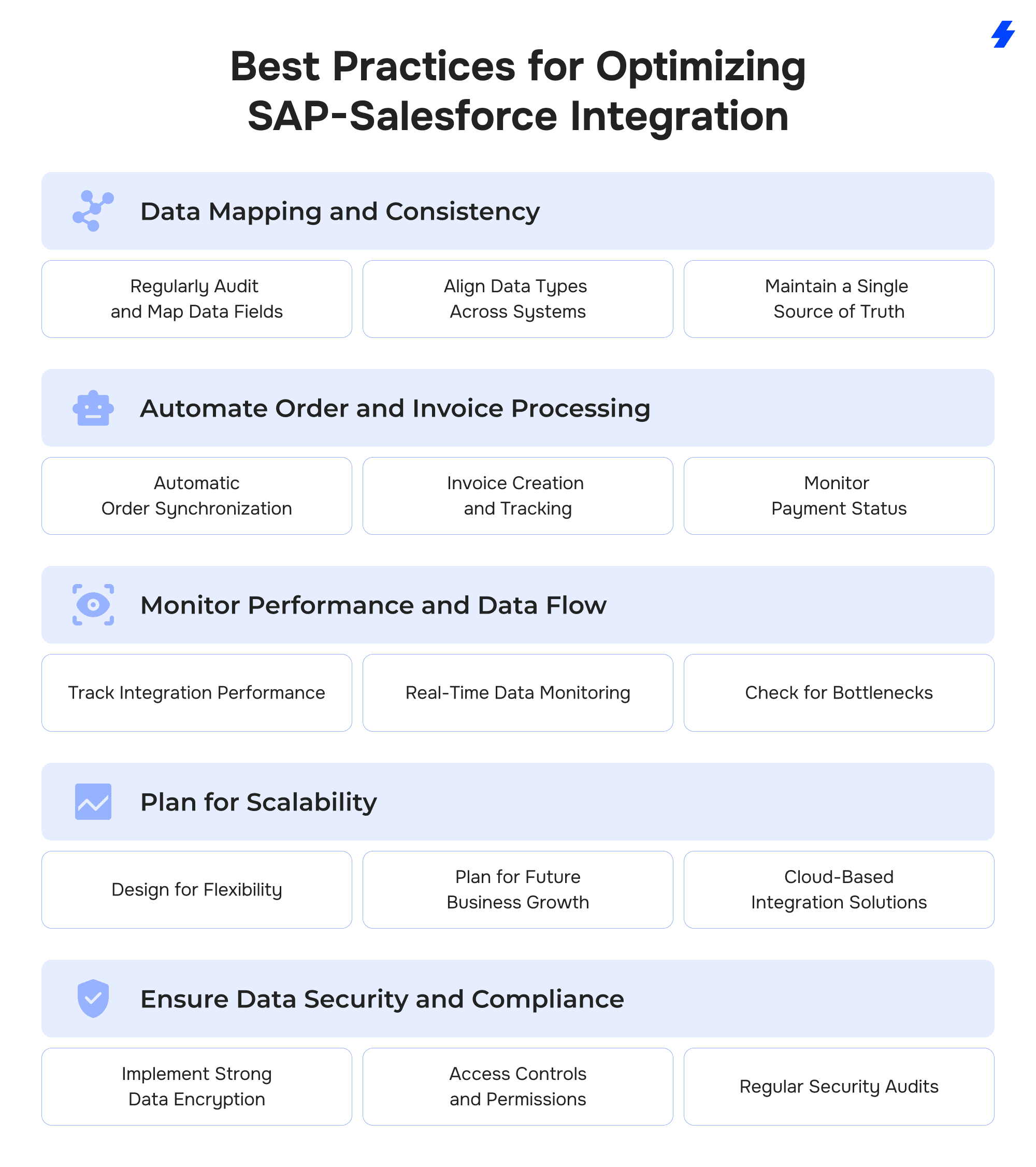
1. Data Mapping and Consistency
The foundation of a successful SAP-Salesforce integration is accurate and consistent data. Ensuring that data is correctly mapped between SAP and Salesforce will minimize errors, prevent data discrepancies, and ensure both systems are working from the same set of information.
-
Regularly Audit and Map Data Fields: It is essential to conduct regular audits of the data fields in both systems to ensure they are aligned and consistent. For instance, mapping SAP’s order details to Salesforce opportunities and SAP’s customer information to Salesforce accounts will allow both systems to sync effectively.
-
Align Data Types Across Systems: Make sure the data types (e.g., text, numeric, date) and structures are compatible. Inconsistent data types or naming conventions can result in errors or loss of important data during synchronization.
-
Maintain a Single Source of Truth: By regularly mapping and auditing data, you can avoid the common problem of data duplication or conflicting information between the two systems, which can affect decision-making and performance analytics.
2. Automate Order and Invoice Processing
One of the biggest advantages of SAP-Salesforce integration is the ability to automate order and invoice processing, which eliminates manual data entry and speeds up operations. Automation ensures that customer orders, invoices, and payments are handled promptly and accurately, which improves cash flow and customer satisfaction.
-
Automatic Order Synchronization: When an order is placed in Salesforce, ensure it is automatically synced with SAP’s order management system. This eliminates the need for manual data entry and ensures real-time updates on order status, inventory levels, and shipping information.
-
Invoice Creation and Tracking: Set up an automated system where invoices are automatically generated in SAP when orders are processed in Salesforce. This ensures that invoices are accurate and issued without delay, streamlining billing cycles.
-
Monitor Payment Status: Once payments are processed, automatically sync payment information between SAP and Salesforce to update customer payment status in real-time, improving the efficiency of financial reporting and collections.
3. Monitor Performance and Data Flow
To ensure that the integration continues to operate smoothly, it is essential to actively monitor the performance and data flow between SAP and Salesforce. By doing so, businesses can quickly identify and address any issues that arise and keep the integration running optimally.
-
Track Integration Performance: Use Salesforce dashboards and SAP monitoring tools to track the health of the integration. Set up alerts to notify key stakeholders of potential issues, such as failed data transfers or slow performance, so that they can be addressed quickly.
-
Real-Time Data Monitoring: Monitoring tools should provide real-time insights into data synchronization, showing if there are any delays or errors in the data flow between SAP and Salesforce. This allows IT teams to resolve problems before they impact business operations.
-
Check for Bottlenecks: Regularly analyze data flow to identify any bottlenecks in the integration. For example, if orders are not being processed quickly in SAP after being created in Salesforce, this could indicate a slow connection or a misconfigured integration rule.
4. Plan for Scalability
As your business grows, so does the data flow between SAP and Salesforce. Planning for scalability ensures that your integration can handle an increased volume of transactions, customer data, and orders without performance degradation.
-
Design for Flexibility: Ensure that the integration is designed in a way that can easily scale as your business needs change. This might involve adding new data fields, expanding the number of processes integrated, or enabling more complex workflows.
-
Plan for Future Business Growth: As your customer base and operations grow, the integration should accommodate increased data flow, more users, and additional business processes without requiring a complete overhaul. For example, as you scale, you may want to integrate more modules in SAP or add more functionality to Salesforce.
-
Cloud-Based Integration Solutions: Cloud-based integration platforms, such as SAP Cloud Platform Integration (CPI) or Salesforce Integration Cloud, can provide the necessary flexibility to scale with your business as it grows, offering better resource management and performance optimization.
5. Ensure Data Security and Compliance
As businesses increasingly rely on integrated systems, ensuring the security and compliance of your data is paramount. Both SAP and Salesforce handle sensitive business data, including customer and financial information, making it critical to have robust security measures in place.
-
Implement Strong Data Encryption: Ensure that all data exchanged between SAP and Salesforce is encrypted both in transit and at rest. This helps protect sensitive business information from unauthorized access.
-
Access Controls and Permissions: Set up role-based access controls (RBAC) in both SAP and Salesforce to ensure that only authorized personnel can access and modify sensitive data. This helps maintain compliance with data privacy regulations such as GDPR or CCPA.
-
Regular Security Audits: Conduct regular security audits of the integrated systems to ensure that the integration is secure and compliant with industry standards. Use monitoring tools to track who has accessed or modified sensitive data.
Common Challenges and How to Overcome Them
Integrating SAP with Salesforce comes with several challenges, but with the right strategies in place, these obstacles can be effectively overcome. Below is a detailed table outlining common integration challenges and the solutions businesses can apply to ensure a smooth and efficient integration process.
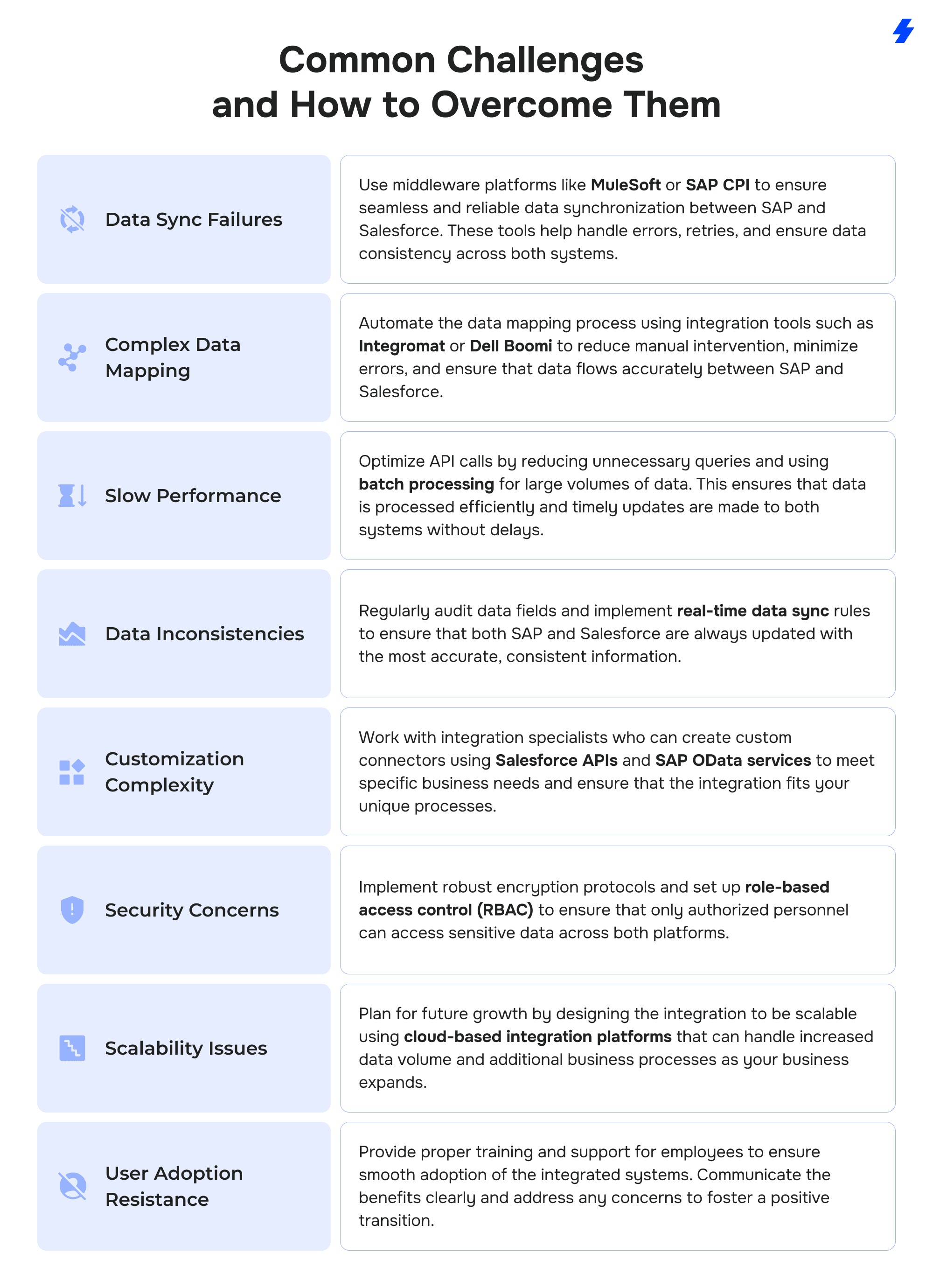
Why Choose MagicFuse
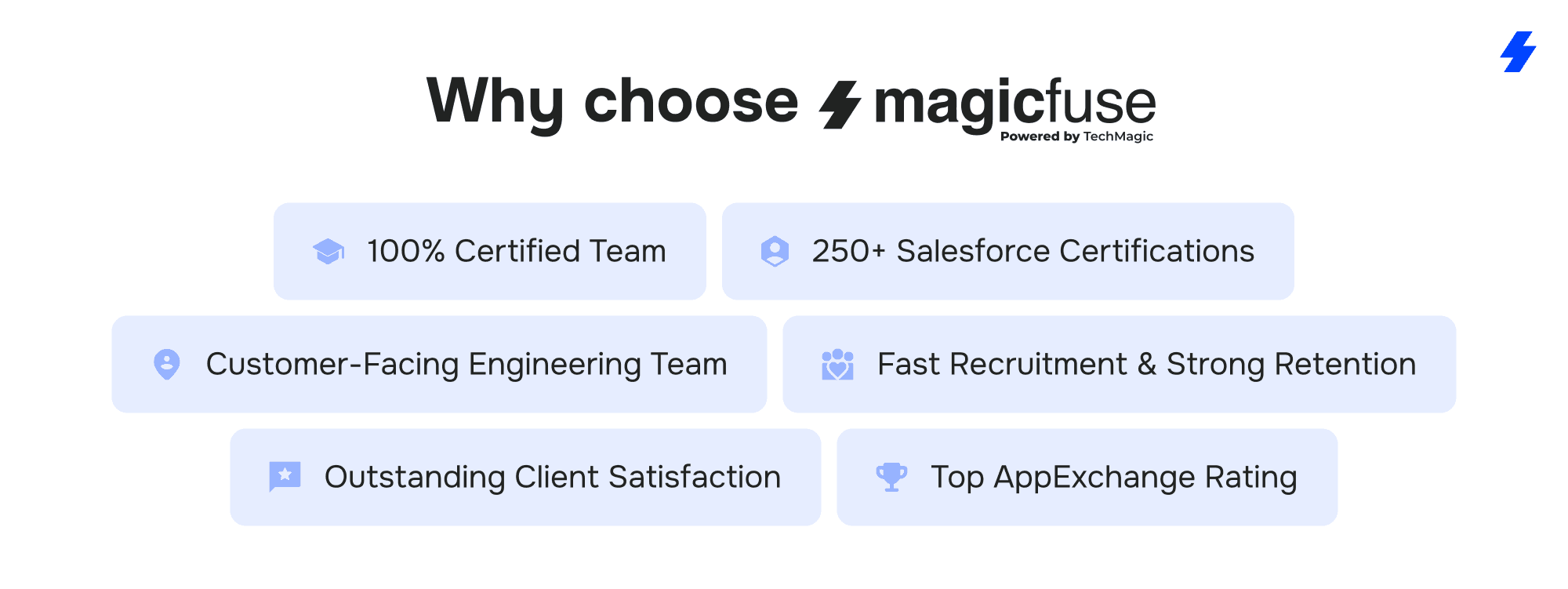
100% Certified Team
Our entire engineering team holds Salesforce certifications, ensuring expert-level knowledge and proven skills to deliver reliable, high-quality solutions.
250+ Salesforce Certifications
With over 250 certifications earned, including recent ones like Experience Cloud Consultant, Data Cloud Consultant, B2B Solution Architect, AI Specialist, and more, we stay at the forefront of Salesforce innovations to meet your evolving needs.
Customer-Facing Engineering Team
We believe in full transparency. Our clients have direct access to our engineers and resources, with no hidden layers, enabling smooth communication and collaborative problem-solving.
Fast Recruitment & Strong Retention
We recruit top Salesforce experts quickly, averaging 6 weeks per hire, while maintaining strong employee retention of over 3 years to provide consistent expertise on your projects.
Outstanding Client Satisfaction
Our commitment to quality is reflected in an impressive Net Promoter Score of 92%, showing that clients trust and recommend our services.
Top AppExchange Rating
With a stellar 4.9-star rating on Salesforce AppExchange, we demonstrate consistent excellence and customer satisfaction in the Salesforce ecosystem.
Contact MagicFuse today to discuss how we can help you overcome integration challenges and unlock your business’s full potential.
FAQs
What are the benefits of integrating SAP with Salesforce?
Integrating SAP with Salesforce offers numerous benefits, including unified data across systems, enhanced customer insights, and automated processes. This integration streamlines order management, improves financial visibility, and enhances reporting and analytics. It reduces data silos and manual entry, leading to increased efficiency, better decision-making, and improved customer experiences.
How does SAP-Salesforce integration improve sales and customer service?
By integrating SAP with Salesforce, sales teams gain real-time access to customer data, including order history, payment status, and inventory levels, all within the Salesforce platform. This helps sales reps personalize their interactions, improve forecasting, and respond to customer inquiries more effectively. For customer service, the integration provides a complete view of customer interactions, helping support teams resolve issues faster and more accurately.
What’s the best way to integrate SAP and Salesforce?
The best way to integrate SAP with Salesforce depends on your business needs and system configurations. Middleware solutions like MuleSoft or SAP Cloud Platform Integration (CPI) are great for most businesses, offering pre-built connectors for ease of integration. Alternatively, businesses with specific requirements can use API-based integration using Salesforce APIs and SAP's OData or SOAP services. For a more customized approach, consider working with an experienced integration partner to ensure the integration is seamless and aligned with your business processes.
Can MagicFuse help customize the SAP-Salesforce integration for my business?
Absolutely! MagicFuse specializes in customizing Salesforce integrations, including SAP. Our team can help design, implement, and optimize the integration to suit your specific business processes and requirements. Whether you need to automate workflows, ensure real-time data sync, or enhance reporting capabilities, MagicFuse has the expertise to create a tailored solution for your organization.
How do I ensure data consistency and accuracy between SAP and Salesforce?
To ensure data consistency and accuracy, it's essential to regularly audit and map data fields between SAP and Salesforce. Use integration tools that automate this process to reduce errors and ensure synchronization across both systems. Implement real-time data sync and configure automatic data transfer rules to keep both systems up-to-date. Regular monitoring and validation checks also help maintain data integrity and avoid discrepancies.
















